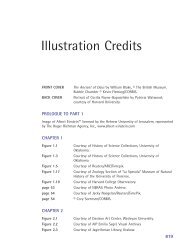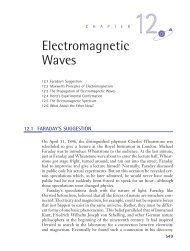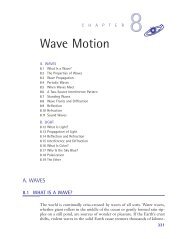Chapter 9: Einstein and Relativity Theory (319 KB) - D Cassidy Books
Chapter 9: Einstein and Relativity Theory (319 KB) - D Cassidy Books
Chapter 9: Einstein and Relativity Theory (319 KB) - D Cassidy Books
Create successful ePaper yourself
Turn your PDF publications into a flip-book with our unique Google optimized e-Paper software.
3637_<strong>Cassidy</strong>TX_09 6/14/02 12:08 PM Page 416<br />
416 9. EINSTEIN AND RELATIVITY THEORY<br />
FIGURE 9.4 Running alongside<br />
a beam of light.<br />
ride alongside, he would not see a wave propagating. Instead, he would see<br />
the “valleys” <strong>and</strong> “crests” of the wave fixed <strong>and</strong> stationary with respect to<br />
him. This contradicted Maxwell’s theory, in which no such “stationary”<br />
l<strong>and</strong>scape in free space was possible. From these <strong>and</strong> other, chiefly theoretical<br />
considerations, <strong>Einstein</strong> concluded by 1905 that Maxwell’s theory<br />
must be reinterpreted: the speed of light will be exactly the same—a universal<br />
constant—for all observers, no matter whether they move (with constant<br />
velocity) relative to the source of the light. This highly original insight<br />
became <strong>Einstein</strong>’s second postulate of special relativity, the Principle<br />
of the Constancy of the Speed of Light:<br />
Light <strong>and</strong> all other forms of electromagnetic radiation are propagated<br />
in empty space with a constant velocity c which is independent<br />
of the motion of the observer or the emitting body.<br />
<strong>Einstein</strong> is saying that, whether moving at uniform speed toward or away<br />
from the source of light or alongside the emitted light beam, any observer<br />
always measures the exact same value for the speed of light in a vacuum,<br />
which is about 3.0 10 8 m/s or 300,000 km/s (186,000 mi/s). (More precisely,<br />
it is 299,790 km/s.) This speed was given the symbol c for “constant.”<br />
If light travels through glass or air, the speed will be slower, but the speed<br />
of light in a vacuum is one of the universal physical constants of nature. (Another<br />
is the gravitational constant G.) It is important to note that, again,<br />
this principle holds only for observers <strong>and</strong> sources that are in inertial reference<br />
frames. This means they are moving at uniform velocity or are at<br />
rest relative to each other.<br />
In order to see how odd the principle of the constancy of the speed of<br />
light really is, let’s consider a so-called “thought experiment,” an experiment<br />
that one performs only in one’s mind. It involves two “virtual student researchers.”<br />
One, whom we’ll call Jane, is on a platform on wheels moving<br />
at a uniform speed of 5 m/s toward the second student, John, who is st<strong>and</strong>ing<br />
on the ground. While Jane is moving, she throws a tennis ball to John<br />
at 7 m/s. John catches the ball, but before he does he quickly measures its<br />
speed (this is only a thought experiment!). What speed does he obtain . . .<br />
The answer is 5 m/s 7 m/s 12 m/s, since the two speeds combine.






